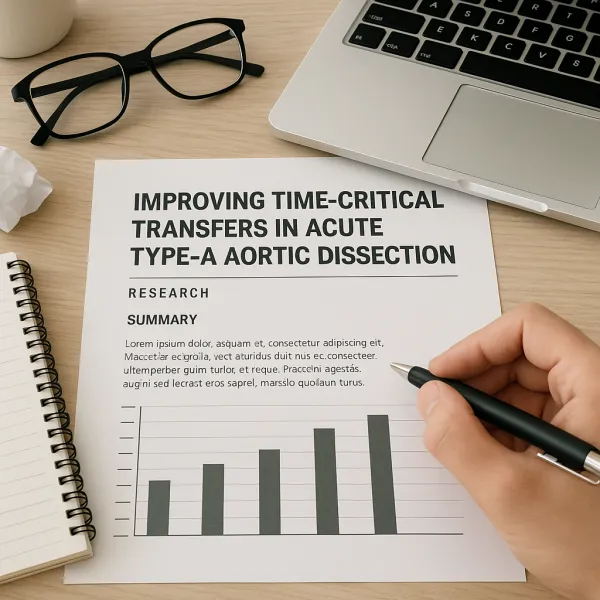Improving Time-Critical Transfers in Acute Type-A Aortic Dissection: Insights from a UK Audit
Acute Type-A aortic dissection is a life-threatening condition demanding rapid diagnosis and transfer for surgical repair. The recent UK audit by Gilbey et al. sheds light on current practice in the UK and identifies key bottlenecks and opportunities for improvement.

What the Study Investigated
The authors audited cases of patients with acute Type-A aortic dissection across 28 UK centres, focusing on two main phases:
- Time to diagnosis (including recognition, imaging, and decision making)
- Time to transfer to an aortic surgical centre for definitive management
Their goal was to provide a “snapshot” of real-world practice, to highlight delays and variation in care pathways.
associationofanaesthetists-publications.onlinelibrary.wiley.com+1
Key Findings
- High acuity and rapid deterioration – Patients presenting with Type-A dissection have a narrow window for optimal intervention; delays are associated with worse outcomes. associationofanaesthetists-publications.onlinelibrary.wiley.com
- Variability in transfer times – There was considerable variation in how long it took from presentation to transfer for surgery. Some of this variation appears driven by imaging delays, decision-making, availability of surgical centres, and transport logistics. associationofanaesthetists-publications.onlinelibrary.wiley.com+1
- Critical role of the “door-to-knife” time – The audit reinforces that beyond surgical skill, the system’s ability to diagnose and transfer swiftly is a major determinant of outcome.
- System-wide gaps – The authors identified gaps in pre-hospital recognition, interventional imaging availability, clarity in referral pathways, and timely transport to surgical centres.
Implications for Clinical Practice & Systems
- Pre-hospital and emergency department awareness: Because time is so pressing in Type-A dissection, first-contact clinicians (paramedics, ED physicians) must keep this diagnosis in mind when encountering patients with sudden severe chest/back pain.
- Imaging readiness and decision support: Rapid CT (or other advanced imaging) is key. Systems should be in place to prioritise suspected dissections and minimise delay from scan to diagnosis.
- Transfer protocols: Clear referral and transport pathways to centres capable of emergency surgical repair are essential. Inter-hospital coordination (including retrieval services) requires defined protocols and regular audit.
- Monitoring performance: The audit provides a benchmark; centres can use similar metrics (e.g., time from arrival to diagnosis, arrival to transfer, transfer to incision) to monitor and improve their performance over time.
Take-home Messages for Patients and Families
- Recognise that sudden, severe chest or back pain that sets in at maximum intensity within minutes may signal aortic dissection.
- If you or a loved one transferred from a hospital without on-site aortic surgery, ask about how transfers are organised and the expected time-frame.
- Hospitals that treat aortic dissection should ideally report their transfer metrics and outcomes — transparency can help you ask informed questions about care.
Conclusion
The audit by Gilbey et al. importantly highlights that while surgical techniques for Type-A dissection continue to evolve, system-wide logistics — from initial suspicion through to transfer — remain critical. For healthcare systems, the task is clear: streamline recognition, imaging and transfer workflows to ensure patients receive definitive repair as soon as possible. Within provider localities, reinforcing these system- and patient-focused messages can help raise awareness and promote timely care for this devastating condition.
Reference
Gilbey T., et al. Time-critical diagnoses and transfers of patients with acute Type-A aortic dissection. Anaesthesia. 2025. DOI:10.1111/anae.16443. associationofanaesthetists-publications.onlinelibrary.wiley.com+1


